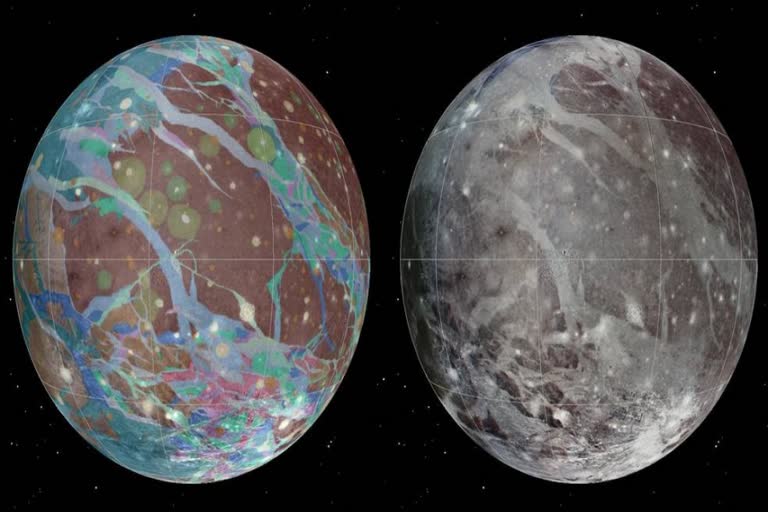Washington: NASA's Juno spacecraft will come within 645 miles (1,038 kilometers) of the surface of Jupiter's largest moon, Ganymede on June 7, the US space agency said on Friday.
The solar-powered Juno spacecraft will fly past Ganymede at 1:35 p.m. EDT (10:35 a.m. PDT). The flyby will be the closest-known since NASA's Galileo spacecraft made its penultimate close approach back on May 20, 2000.
The flyby will yield striking insights into the moon's composition, ionosphere, magnetosphere, and ice shell. Juno's measurements of the radiation environment near the moon will also benefit future missions to the Jovian system -- encompassing Jupiter, its rings and moons, NASA said.
-
Ganymede is the largest moon in the solar system, bigger even than the planet Mercury. We'll get the closest look at Ganymede we’ve had in more than 20 years when our #JunoMission makes a close flyby on June 7. Learn more: https://t.co/zMru5iSvCk pic.twitter.com/ZXXl13lXv3
— NASA Solar System (@NASASolarSystem) June 3, 2021 " class="align-text-top noRightClick twitterSection" data="
">Ganymede is the largest moon in the solar system, bigger even than the planet Mercury. We'll get the closest look at Ganymede we’ve had in more than 20 years when our #JunoMission makes a close flyby on June 7. Learn more: https://t.co/zMru5iSvCk pic.twitter.com/ZXXl13lXv3
— NASA Solar System (@NASASolarSystem) June 3, 2021Ganymede is the largest moon in the solar system, bigger even than the planet Mercury. We'll get the closest look at Ganymede we’ve had in more than 20 years when our #JunoMission makes a close flyby on June 7. Learn more: https://t.co/zMru5iSvCk pic.twitter.com/ZXXl13lXv3
— NASA Solar System (@NASASolarSystem) June 3, 2021
Ganymede is bigger than the planet Mercury and is the only moon in the solar system with its own magnetosphere -- a bubble-shaped region of charged particles surrounding the celestial body.
"Juno carries a suite of sensitive instruments capable of seeing Ganymede in ways never before possible," said Scott Bolton, Juno Principal Investigator of the Southwest Research Institute in San Antonio.
"By flying so close, we will bring the exploration of Ganymede into the 21st century, both complementing future missions with our unique sensors and helping prepare for the next generation of missions to the Jovian system -- NASA's Europa Clipper and ESA's (European Space Agency's) JUpiter ICy moons Explorer [JUICE] mission," Bolton said.
-
Exploring Jupiter & beyond. The Galileo spacecraft flew by Jupiter’s largest moon, Ganymede, 21 years ago. Now, #JunoMission will conduct its own back-to-back flybys that will provide data & support for future missions, such as @EuropaClipper & @ESA_JUICE. https://t.co/LIWTiCuN5B pic.twitter.com/k2hqQKo0tX
— NASA JPL (@NASAJPL) June 4, 2021 " class="align-text-top noRightClick twitterSection" data="
">Exploring Jupiter & beyond. The Galileo spacecraft flew by Jupiter’s largest moon, Ganymede, 21 years ago. Now, #JunoMission will conduct its own back-to-back flybys that will provide data & support for future missions, such as @EuropaClipper & @ESA_JUICE. https://t.co/LIWTiCuN5B pic.twitter.com/k2hqQKo0tX
— NASA JPL (@NASAJPL) June 4, 2021Exploring Jupiter & beyond. The Galileo spacecraft flew by Jupiter’s largest moon, Ganymede, 21 years ago. Now, #JunoMission will conduct its own back-to-back flybys that will provide data & support for future missions, such as @EuropaClipper & @ESA_JUICE. https://t.co/LIWTiCuN5B pic.twitter.com/k2hqQKo0tX
— NASA JPL (@NASAJPL) June 4, 2021
The Europa Clipper is slated for a launch in October 2024 and expected to arrive in April 2030, while JUICE is planned for launch in 2022 and arrival at Jupiter in 2029.
Further, Juno's Stellar Reference Unit (SRU) navigation camera will help keep the Jupiter orbiter on course. It will also gather information on the high-energy radiation environment in the region near Ganymede by collecting a special set of images.
Meanwhile, the Advanced Stellar Compass camera will count very energetic electrons that penetrate its shielding with a measurement every quarter of a second. And the JunoCam imager will collect images at a resolution equivalent to the best from Voyager and Galileo.
Due to the speed of the flyby, the icy moon will -- from JunoCam's viewpoint -- go from being a point of light to a viewable disk, then back to a point of light in about 25 minutes. So that's just enough time for five images, NASA said.
"Things usually happen pretty quickly in the world of flybys, and we have two back-to-back next week. So literally every second count," said Juno Mission Manager Matt Johnson of JPL.
"On Monday, we are going to race past Ganymede at almost 12 miles per second (19 kilometers per second). Less than 24 hours later we're performing our 33rd science pass of Jupiter -- screaming low over the cloud tops, at about 36 miles per second (58 kilometers per second). It is going to be a wild ride," he added.
Also Read: GOQii unveils smartwatch for kids with a colorful display and straps
(Inputs from IANS + NASA)



